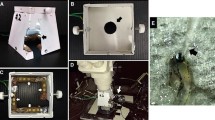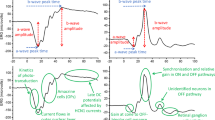Abstract
Purpose
The electroretinogram (ERG) is a powerful approach for investigating visual function in zebrafish ocular disease models. However, complexity, cost, and a literature gap present as significant barriers for the introduction of this technology to new zebrafish laboratories. Here, we introduce a simplified and effective method to obtain zebrafish ERGs.
Methods
In-house assembled recording electrodes and a custom 3D-printed platform were used to gather high-quality and consistent ERG data from zebrafish at 3 developmental timepoints—larval, juvenile, and adult. Fish were tested under both scotopic (dark-adapted) and photopic (light-adapted) conditions to differentiate between the rod and cone systems, respectively.
Results
Robust ERG waveforms across all developmental timepoints were obtained using the methodology presented here. We observed an overall increase in signal amplitude as development progressed, reflecting maturation of the zebrafish retina. Oscillatory potentials could also be isolated from the generated waveforms.
Conclusions
This simplified approach to the zebrafish ERG can generate waveforms comparable to the existing approaches and helps reduce barriers for zebrafish laboratories studying ocular development and disease.






Similar content being viewed by others
Availability of data and materials
The data used during this study are available from the corresponding author on reasonable request.
References
Richardson R, Tracey-White D, Webster A, Moosajee M (2017) The zebrafish eye-a paradigm for investigating human ocular genetics. Eye 31:68–86. https://doi.org/10.1038/eye.2016.198
Dai J, He J, Wang G et al (2017) Contribution of GABAa, GABAc and glycine receptors to rat dark-adapted oscillatory potentials in the time and frequency domain. Oncotarget 8:77696–77709
Sillman AJ, Ito H, Tomita T (1969) Studies on the mass receptor potential of the isolated frog retina. Vis Res 9:1435–4451
Brown KT (1969) The electroretinogram: its components and their origins. Vis Res 8:633–677. https://doi.org/10.1016/0042-6989(68)90041-2
Gurevich L, Slaughter MM (1993) Comparison of the waveforms of the ON bipolar neuron and the b-wave of the electroretinogram. Vis Res 33:2431–2435
Noell WK (1954) The origin of the electroretinogram. Am J Ophthalmol 38:78–93. https://doi.org/10.1016/0002-9394(54)90012-4
Steinberg RH, Schmidt R, Brown KT (1970) Intracellular responses to light from cat pigment epithelium: origin of the electroretinogram c-wave. Nature 227:728–730
Fleisch VC, Jametti T, Neuhauss SCF (2008) Electroretinogram (ERG) measurements in larval zebrafish. Cold Spring Harb Protoc 3:1–6. https://doi.org/10.1101/pdb.prot4973
Saszik S, Bilotta J (1999) ERG assessment of zebrafish retinal development. Vis Neurosci 16:881–888. https://doi.org/10.1017/S0952523899165076
Xie J, Jusuf PR, Goodbourn PT, Bui BV (2019) Electroretinogram recording in larval zebrafish using a novel cone-shaped sponge-tip electrode. J Vis Exp. https://doi.org/10.3791/59487
Sun C, Mitchell DM, Stenkamp DL (2018) Isolation of photoreceptors from mature, developing, and regenerated zebrafish retinas, and of microglia/macrophages from regenerating zebrafish retinas. Exp Eye Res 177:130–144. https://doi.org/10.1016/j.exer.2018.08.002
McCulloch DL, Marmor MF, Brigell MG et al (2015) ISCEV Standard for full-field clinical electroretinography (2015 update). Doc Ophthalmol 130:1–12. https://doi.org/10.1007/s10633-014-9473-7
Gauthier M, Gauvin M, Lina JM, Lachapelle P (2019) The effects of bandpass filtering on the oscillatory potentials of the electroretinogram. Doc Ophthalmol 138:247–254. https://doi.org/10.1007/s10633-019-09683-w
Seeliger MW, Rilk A, Neuhauss SCF (2002) Ganzfeld ERG in zebrafish larvae. Doc Ophthalmol 104:57–68. https://doi.org/10.1023/A:1014454927931
Jardon B, Yiicel H, Bonaventure N (1989) Glutamatergic separation of ON and OFF retinal channels: possible modulation by glycine and acetylcholine. Eur J Pharmacol 162:215–224
Nelson RF, Singla N (2009) A spectral model for signal elements isolated from zebrafish photopic electroretinogram. Vis Neurosci 26:349–363. https://doi.org/10.1017/S0952523809990113
Demarco PJ, Powers MK (1989) Sensitivity of ERG components from dark-adapted goldfish retinas treated with APB. Brain Res 482:317–323
Wong KY, Adolph AR, Dowling JE (2004) Retinal bipolar cell input mechanisms in giant danio: electroretinographic analysis. J Neurophysiol 93:84–93. https://doi.org/10.1152/jn.00259.2004
Branchek T (1984) The development of photoreceptors in the zebrafish, Brachydanio rerio. J Comput Neurol 224:116–122. https://doi.org/10.1002/cne.902240110
Kizawa J, Machida S, Kobayashi T et al (2006) Changes of oscillatory potentials and photopic negative response in patients with early diabetic retinopathy. Jpn J Ophthalmol 50:367–373. https://doi.org/10.1007/s10384-006-0326-0
Acknowledgements
The authors would like to thank Dr. Yves Sauvé and Dr. Orson Moritz for sharing their extensive technical skills and knowledge of ERG recordings. We would also like to thank Science Animal Support Services at the University of Alberta for their excellent care of the zebrafish aquatics facility.
Funding
This work was supported by an Alberta Vision Net Catalyst Grant (JCH), Natural Sciences and Engineering Research Council of Canada (NSERC) Discovery Grant (RGPIN-2018-05756, JCH), Alberta Graduate Excellence Scholarship (NJN), NSERC Canada Graduate Student—Master’s Grant (NJN), Queen Elizabeth II Graduate Scholarship (NJN), Walter H. Johns Graduate Fellowship (NJN), a Faculty of Medicine and Dentistry (University of Alberta)/Alberta Health Services Graduate Student Recruitment Studentship (NJN), a Department of Surgery (University of Alberta) Summer Studentship (CXLW), and an NSERC Undergraduate Student Research Award. The research was also funded by the generous support of the Stollery Children's Hospital Foundation through a Women and Children’s Health Research Institute Innovation Grant (WCHRIIG-2846, JCH) and a summer studentship (CXLW).
Author information
Authors and Affiliations
Contributions
All authors contributed to the study conception and design. Material preparation, data collection, and analysis were performed by Nathan Nadolski and Casey Wong. The first draft of the manuscript was written by Nathan Nadolski, and all authors commented on previous versions of the manuscript. All authors read and approved the final manuscript.
Corresponding author
Ethics declarations
Conflict of interest
The authors declare that they have no conflict of interest.
Consent for publication
N.J. Nadolski, Yes; C.X.L. Wong, Yes; J.C. Hocking, Yes.
Ethical approval
Animal ethics protocols were approved by the University of Alberta Biosciences Animal Care Committee (AUP1476).
Informed consent
Informed consent was not applicable.
Statement of human rights
This article does not contain any studies with human participants performed by any of the authors.
Statement on the welfare of animals
All applicable international, national, and/or institutional guidelines for the care and use of animals were followed. All procedures performed in studies involving animals were in accordance with the ethical standards of the institution or practice at which the studies were conducted.
Additional information
Publisher's Note
Springer Nature remains neutral with regard to jurisdictional claims in published maps and institutional affiliations.
Electronic supplementary material
Below is the link to the electronic supplementary material.
Supplementary Figure 1
Scotopic b-wave amplitude comparisons across development for individual stimulus intensities. Scotopic b-wave amplitudes for each age cohort in response to a) -0.7 log cd•s/m2, b) 0.0 log cd•s/m2, and c) 1.0 log cd•s/m2 stimulus intensities are compared. Boxes extend from the 25-75% percentiles, internal lines represent the median, and whiskers complete the range. n=15 for 7 dpf, n=10 for 1 mpf, and n=10 for 4 mpf. *P<0.05; **P<0.01; ***P<0.001 (TIF 8337 kb)
Supplementary File 1
3D model of the ERG platform visualized in Figure 1b. This model can be downloaded as an .stl file, modified as necessary, and then 3D printed with polylactic acid (PLA) filament using the appropriate hardware (STL 57 kb)
Rights and permissions
About this article
Cite this article
Nadolski, N.J., Wong, C.X.L. & Hocking, J.C. Electroretinogram analysis of zebrafish retinal function across development. Doc Ophthalmol 142, 99–109 (2021). https://doi.org/10.1007/s10633-020-09783-y
Received:
Accepted:
Published:
Issue Date:
DOI: https://doi.org/10.1007/s10633-020-09783-y




